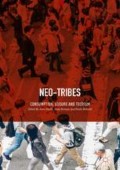Abstract
This chapter introduces the concept of neo-tribes and provides an in-depth, critical evaluation of its impact and influence on contemporary academic writing, by focusing upon aspects of culture and society. In the first instance, the chapter considers how neo-tribal theory has been applied across a variety of disciplines, often to different ends, with the result that the neo-tribal lens is somewhat multifarious. While this is to be expected when a concept assumes a multi-disciplinary resonance in the way that neo-tribes has, a key contention of this chapter is that there is a critical need to begin weaving together some of the conceptual threads pursued through the adoption and adaptation of neo-tribal theory across diverse disciplinary areas. Such a synthesis is necessary, it is argued, in order to ensure an underlying cohesion in both the way that neo-tribalism is understood by academic researchers and how it is applied as a theoretical framework.
Access this chapter
Tax calculation will be finalised at checkout
Purchases are for personal use only
References
Bauman, Z. (1992). Intimations of Postmodernity. London: Routledge.
Beck, U. (1992). Risk Society: Towards a New Modernity. London: Sage.
Bennett, A. (1999). Subcultures or Neo-Tribes?: Rethinking the Relationship Between Youth, Style and Musical Taste. Sociology, 33(3), 599–617.
Bennett, A. (2005). In Defence of Neo-Tribes: A Response to Blackman and Hesmondhalgh. Journal of Youth Studies, 8(2), 255–259.
Bourdieu, P. (1984). Distinction: A Social Critique of the Judgement of Taste. Cambridge: Harvard University Press.
Bourdieu, P. (1987). What Makes a Social Class? On the Theoretical and Practical Existence of Groups. Berkley Journal of Sociology, 22, 1–17.
Bourdieu, P. (1991). Language and Symbolic Power. Cambridge: Harvard University Press.
Collins, R. (1981). On the Microfoundations of Macrosociology. American Journal of Sociology, 86(5), 984–1014.
Collins, R. (2004). Interaction Ritual Chains. Princeton: Princeton University Pres.
Cova, B., & Cova, V. (2002). Tribal Marketing: The Tribalisation of Society and Its Impact on the Conduct of Marketing. European Journal of Marketing, 36(5–6), 595–620.
Crook, S. (1998). Minotaurs and Other Monsters: ‘Everyday Life’ in Recent Social Theory. Sociology, 32(2), 523–540.
Driver, C., & Bennett, A. (2015). Music Scenes, Space and the Body. Cultural Sociology, 9(1), 99–115.
Durkheim, É. (1984). The Division of Labour in Society. New York: Free Press.
Durkheim, É. (2001). The Elementary Forms of Religious Life. Oxford: Oxford University Press.
Furedi, F. (1997). The Culture of Fear: Risk-Taking and the Morality of Low Expectation. London: Cassell.
Giddens, A. (1991). Modernity and Self-Identity: Self and Society in the Late Modern Age. Cambridge: Polity Press.
Goffman, E. (1956). The Nature of Deference and Demeanor. American Anthropologist, 58, 473–502.
Goffman, E. (1959). The Presentation of Self in Everyday Life. New York: Doubleday.
Goffman, E. (1981). Forms of Talk. Philadelphia: University of Pennsylvania Press.
Hardy, A., & Gretzel, U. (2011). Why We Travel This Way: An Exploration into the Motivations of Recreational Vehicle Users. In D. Carson & B. Prideaux (Eds.), Drive Tourism: Trends and Emerging Markets. London: Routledge.
Hardy, A., & Robards, B. (2015). The Ties That Bind: Exploring Neo-Tribal Theory’s Relevance to Tourism. Tourism Analysis, 20(4), 443–454.
Hardy, A., Gretzel, U., & Hanson, D. (2013). Travelling Neo-Tribes: Conceptualising Recreational Vehicle Users. Journal of Tourism and Cultural Change, 11(1–2), 48–60.
Heath, S. (2004). Peer-Shared Households, Quasi-Communes and Neo-Tribes. Current Sociology, 52(2), 161–179.
Johnson, G. J., & Ambrose, P. (2006). Neo-Tribes: The Power and Potential of Online Communities in Health Care. Communications of the ACM—Personal Information Management, 49(1), 107–113.
Kriwoken, L., & Hardy, A. (2017). Neo-Tribes and Antarctic Expedition Cruise Ship Tourists. Annals of Leisure Research, 1–18. https://doi.org/10.1080/11745398.2017.1286512
Maffesoli, M. (1996). The Time of the Tribes: The Decline of Individualism in Mass Society (D. Smith, Trans.). London: Sage.
Malbon, B. (1998). The Club, Clubbing: Consumption, Identity and the Spatial Practices of Every-Night Life. In T. Skelton & G. Valentine (Eds.), Cool Places: Geographies of Youth Cultures. London: Routledge.
Malbon, B. (2002). Clubbing: Dancing, Ecstasy and Vitality. London: Routledge.
Robards, B., & Bennett, A. (2011). My Tribe: Postsubcultural Manifestations of Belonging on Social Network Sites. Sociology, 45(2), 303–317.
Shields, R. (1992). The Individual, Consumption Cultures and the Fate of Community. In R. Shields (Ed.), Lifestyle Shopping: The Subject of Consumption. London: Routledge.
Wang, J. (2005). Bourgeois Bohemians in China? Neo-Tribes and the Urban Imaginary. The China Quarterly, 183, 532–548.
Author information
Authors and Affiliations
Editor information
Editors and Affiliations
Rights and permissions
Copyright information
© 2018 The Author(s)
About this chapter
Cite this chapter
Hardy, A., Bennett, A., Robards, B. (2018). Introducing Contemporary Neo-Tribes. In: Hardy, A., Bennett, A., Robards, B. (eds) Neo-Tribes. Palgrave Macmillan, Cham. https://doi.org/10.1007/978-3-319-68207-5_1
Download citation
DOI: https://doi.org/10.1007/978-3-319-68207-5_1
Published:
Publisher Name: Palgrave Macmillan, Cham
Print ISBN: 978-3-319-68206-8
Online ISBN: 978-3-319-68207-5
eBook Packages: Literature, Cultural and Media StudiesLiterature, Cultural and Media Studies (R0)

